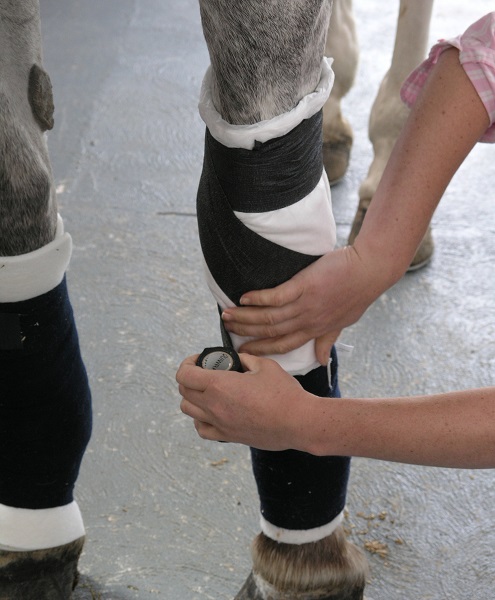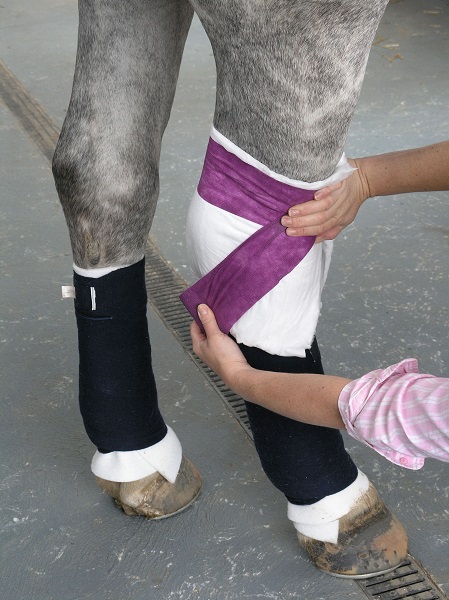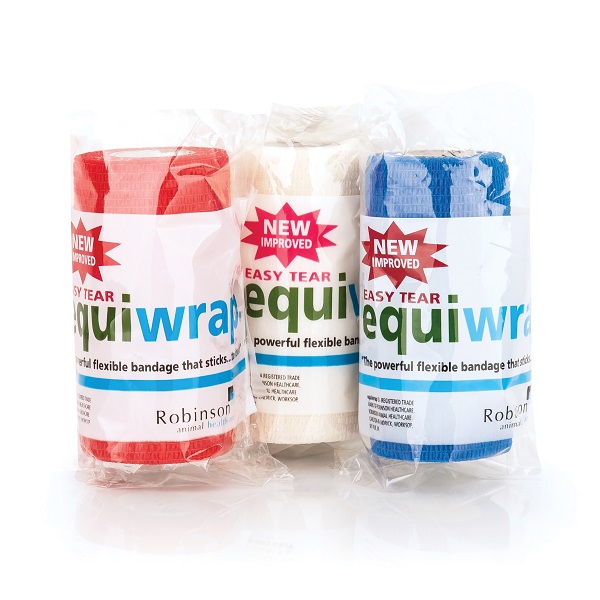Posted: 20th March 2018 | Back to news feed

Bandaging Tricky Areas
Bandaging is a skill that gets better with practice; however there may be an occasion when you are required to bandage areas that are slightly more difficult to tackle such as the knee or hock.
If you are faced with the need to bandage one of these tricky joints it is likely your horse will have suffered an injury and you need to protect the wound or secure a poultice in place to draw out infection.
A bandage should never restrict circulation, as this can cause serious damage and affect the healing process. For knee or hock wounds use a figure-of-eight bandage, crossing at the front of the knee or hock, making sure the bandage does not restrict movement, unless you are bandaging to immobilise the joint.
Bandaging the Knee
The knee is not an easy joint to bandage, as it is freely moveable and any bandaging needs to allow for freedom of movement.

The most sensitive part of the knee is the accessory carpal bone at the back of the knee. If a bandage it too tight at this point it will restrict the circulation and can cause severe problems.
A useful tip is to avoid bandaging over these areas and to cut a relief hole in the Veterinary Gamgee® to avoid pressure sores.
Plenty of padding around the knee is essential and the figure-of-eight method of bandaging leaves the back of the knee free from pressure and allows adequate movement.
Start by bandaging around the top of the knee joint a couple of turns and then go down and across front of the knee to below the knee joint. Then go then around below the knee joint a couple of turns before crossing back up and across the knee to the top of the knee joint and again around the back of the knee itself. This is your basic figure-of-eight method and can be repeated as necessary.
Always apply standard stable bandages below the knee on both legs for support and this also helps to prevent the knee bandage from slipping.
Bandaging the Hock
Again start by bandaging both hind legs with standard stable bandages to offer support to the hock.

The prominent bone on the inside of the hock is most vulnerable to pressure and must be avoided when bandaging. Use plenty of padding that covers above and below the joint, using Veterinary Gamgee®.
As with the knee, use a figure-of-eight method starting above the hock and bandaging a couple of turns then cross down over the front of the hock to just below the joint, before doing a couple more turns and cross back up over the front of the hock to the top.
Always check that the dressing and padding are in place and secure and that the sensitive points are well covered but not tightly bandaged.
With movement, hock dressings have a tendency to slip and move, do not worry too much about this, just regularly check the bandage and if it needs reapplying you can bandage it again.
Knowing the anatomy of the limb will assist in effective and efficient bandaging. If you are in any doubt about bandaging technique’s you should contact your veterinary surgery for advice. Remember firm but not restrictive application and practice makes perfect.
Equiwrap® Cohesive bandages quickly and easily secure a dressing or bandage in place without restricting movement and come in a range of colours to brighten up your first aid kit. Flexible and lightweight it shapes to the awkward contours of the legs providing support and protection, making Equiwrap® the perfect choice for bandaging the knee and hock.

Robinson Animal Healthcare has a wide range of products for all your first aid requirements.
For more information on the Robinson Animal Health Care range contact them on 01909 735000 or visit www.robinsonhealthcare.com
The Equestrian Index newsfeed is compiled from articles submitted by advertising members and expresses the opinions of those members. Watsons Directories Ltd shall not be held liable for any inaccuracies or mis-statements therein.
